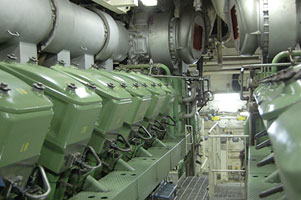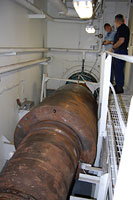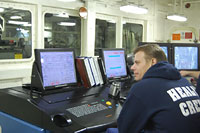

 | |||||||||||||||||||||||
|
|
Journals 2009/2010Jonathan Pazol
August 31, 2009 Even after 3 1/2 weeks, there are still parts of the Healy that I did not know existed until recently - like the "secret" air hockey table at the very bow in one of the lower decks. At 128 meters (420 feet) in length, 25 meters (82 feet) in width, and a displacement of 16,000 long tons, the ship is incredible in scale.
With more than 4,200 square feet of lab space divided between 6 separate labs, cranes and oceanographic winches, room for 2 helicopters, and accommodations for more than 130 scientists and crew, the Healy has to have some very large engineering systems just to operate, and even more capacity to do it while breaking ice. I have had the opportunity to take several engineering tours of the ship, and I wanted to explain a little bit for people who like to know how things work. The Healy runs on 4 Sultzer diesel engines with a capacity of 4.621 million liters (1.22 million gallons) of fuel - imagine the bill for "filling up" the tanks. This amount of fuel can allow the ship to run its engines for 60 consecutive days in ice. Normally, running a single engine uses between 8,000 - 10,000 gallons of diesel in 24 hours. The engines then run generators, which control the rest of the ship's systems and produce 6600 volts of electricity.
From the generators, the electricity runs through 3 different places - a motor-generator, which produces "clean," sensitive power for computers, lights, etc., a transformer for non-sensitive systems such as pumps, and a cycloconverter, which transforms the energy into systems used for propulsion. This system rotates the propeller shafts, which turn the propellers, providing a maximum horsepower of 30,000 HP and a maximum speed of 17 Knots (nautical miles) per hour.
All of the systems on the ship are compartmentalized into separate rooms. That way, if there was a fire or flood in one of the areas, the entire ship would not be disabled. The systems can also be run in different configurations, so that again, if there is a problem in one area, the others can be turned on instead. All of this is controlled by a Machinery Control and Monitoring System (MPCMS), which can receive inputs from 5000 data points and allows for remote operation of most of the systems. The MPCMS is continuously staffed by Coast Guard personnel from a control room. The complexities of the engineering system are quite amazing - the automation allows the Healy to run by fewer crew members than the other, smaller icebreakers, and the people who work in this area have some impressive expertise.
After learning all of this, I wish I had taken some Industrial Technology courses, so I would understand the engineering systems better. |
||||||||||||||||||||||





